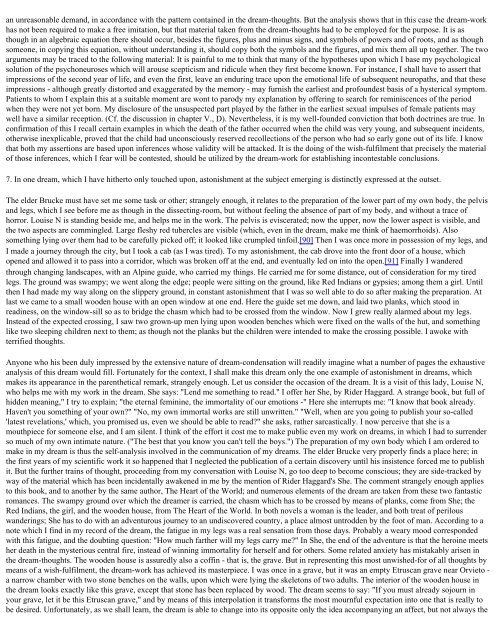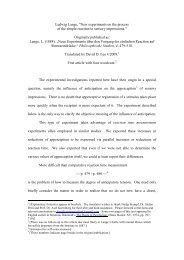The Interpretation Of Dreams Sigmund Freud (1900) PREFACE
The Interpretation Of Dreams Sigmund Freud (1900) PREFACE
The Interpretation Of Dreams Sigmund Freud (1900) PREFACE
You also want an ePaper? Increase the reach of your titles
YUMPU automatically turns print PDFs into web optimized ePapers that Google loves.
an unreasonable demand, in accordance with the pattern contained in the dream-thoughts. But the analysis shows that in this case the dream-work<br />
has not been required to make a free imitation, but that material taken from the dream-thoughts had to be employed for the purpose. It is as<br />
though in an algebraic equation there should occur, besides the figures, plus and minus signs, and symbols of powers and of roots, and as though<br />
someone, in copying this equation, without understanding it, should copy both the symbols and the figures, and mix them all up together. <strong>The</strong> two<br />
arguments may be traced to the following material: It is painful to me to think that many of the hypotheses upon which I base my psychological<br />
solution of the psychoneuroses which will arouse scepticism and ridicule when they first become known. For instance, I shall have to assert that<br />
impressions of the second year of life, and even the first, leave an enduring trace upon the emotional life of subsequent neuropaths, and that these<br />
impressions - although greatly distorted and exaggerated by the memory - may furnish the earliest and profoundest basis of a hysterical symptom.<br />
Patients to whom I explain this at a suitable moment are wont to parody my explanation by offering to search for reminiscences of the period<br />
when they were not yet born. My disclosure of the unsuspected part played by the father in the earliest sexual impulses of female patients may<br />
well have a similar reception. (Cf. the discussion in chapter V., D). Nevertheless, it is my well-founded conviction that both doctrines are true. In<br />
confirmation of this I recall certain examples in which the death of the father occurred when the child was very young, and subsequent incidents,<br />
otherwise inexplicable, proved that the child had unconsciously reserved recollections of the person who had so early gone out of its life. I know<br />
that both my assertions are based upon inferences whose validity will be attacked. It is the doing of the wish-fulfilment that precisely the material<br />
of those inferences, which I fear will be contested, should be utilized by the dream-work for establishing incontestable conclusions.<br />
7. In one dream, which I have hitherto only touched upon, astonishment at the subject emerging is distinctly expressed at the outset.<br />
<strong>The</strong> elder Brucke must have set me some task or other; strangely enough, it relates to the preparation of the lower part of my own body, the pelvis<br />
and legs, which I see before me as though in the dissecting-room, but without feeling the absence of part of my body, and without a trace of<br />
horror. Louise N is standing beside me, and helps me in the work. <strong>The</strong> pelvis is eviscerated; now the upper, now the lower aspect is visible, and<br />
the two aspects are commingled. Large fleshy red tubercles are visible (which, even in the dream, make me think of haemorrhoids). Also<br />
something lying over them had to be carefully picked off; it looked like crumpled tinfoil.[90] <strong>The</strong>n I was once more in possession of my legs, and<br />
I made a journey through the city, but I took a cab (as I was tired). To my astonishment, the cab drove into the front door of a house, which<br />
opened and allowed it to pass into a corridor, which was broken off at the end, and eventually led on into the open.[91] Finally I wandered<br />
through changing landscapes, with an Alpine guide, who carried my things. He carried me for some distance, out of consideration for my tired<br />
legs. <strong>The</strong> ground was swampy; we went along the edge; people were sitting on the ground, like Red Indians or gypsies; among them a girl. Until<br />
then I had made my way along on the slippery ground, in constant astonishment that I was so well able to do so after making the preparation. At<br />
last we came to a small wooden house with an open window at one end. Here the guide set me down, and laid two planks, which stood in<br />
readiness, on the window-sill so as to bridge the chasm which had to be crossed from the window. Now I grew really alarmed about my legs.<br />
Instead of the expected crossing, I saw two grown-up men lying upon wooden benches which were fixed on the walls of the hut, and something<br />
like two sleeping children next to them; as though not the planks but the children were intended to make the crossing possible. I awoke with<br />
terrified thoughts.<br />
Anyone who his been duly impressed by the extensive nature of dream-condensation will readily imagine what a number of pages the exhaustive<br />
analysis of this dream would fill. Fortunately for the context, I shall make this dream only the one example of astonishment in dreams, which<br />
makes its appearance in the parenthetical remark, strangely enough. Let us consider the occasion of the dream. It is a visit of this lady, Louise N,<br />
who helps me with my work in the dream. She says: "Lend me something to read." I offer her She, by Rider Haggard. A strange book, but full of<br />
hidden meaning," I try to explain; "the eternal feminine, the immortality of our emotions -" Here she interrupts me: "I know that book already.<br />
Haven't you something of your own?" "No, my own immortal works are still unwritten." "Well, when are you going to publish your so-called<br />
'latest revelations,' which, you promised us, even we should be able to read?" she asks, rather sarcastically. I now perceive that she is a<br />
mouthpiece for someone else, and I am silent. I think of the effort it cost me to make public even my work on dreams, in which I had to surrender<br />
so much of my own intimate nature. ("<strong>The</strong> best that you know you can't tell the boys.") <strong>The</strong> preparation of my own body which I am ordered to<br />
make in my dream is thus the self-analysis involved in the communication of my dreams. <strong>The</strong> elder Brucke very properly finds a place here; in<br />
the first years of my scientific work it so happened that I neglected the publication of a certain discovery until his insistence forced me to publish<br />
it. But the further trains of thought, proceeding from my conversation with Louise N, go too deep to become conscious; they are side-tracked by<br />
way of the material which has been incidentally awakened in me by the mention of Rider Haggard's She. <strong>The</strong> comment strangely enough applies<br />
to this book, and to another by the same author, <strong>The</strong> Heart of the World; and numerous elements of the dream are taken from these two fantastic<br />
romances. <strong>The</strong> swampy ground over which the dreamer is carried, the chasm which has to be crossed by means of planks, come from She; the<br />
Red Indians, the girl, and the wooden house, from <strong>The</strong> Heart of the World. In both novels a woman is the leader, and both treat of perilous<br />
wanderings; She has to do with an adventurous journey to an undiscovered country, a place almost untrodden by the foot of man. According to a<br />
note which I find in my record of the dream, the fatigue in my legs was a real sensation from those days. Probably a weary mood corresponded<br />
with this fatigue, and the doubting question: "How much farther will my legs carry me?" In She, the end of the adventure is that the heroine meets<br />
her death in the mysterious central fire, instead of winning immortality for herself and for others. Some related anxiety has mistakably arisen in<br />
the dream-thoughts. <strong>The</strong> wooden house is assuredly also a coffin - that is, the grave. But in representing this most unwished-for of all thoughts by<br />
means of a wish-fulfilment, the dream-work has achieved its masterpiece. I was once in a grave, but it was an empty Etruscan grave near Orvieto -<br />
a narrow chamber with two stone benches on the walls, upon which were lying the skeletons of two adults. <strong>The</strong> interior of the wooden house in<br />
the dream looks exactly like this grave, except that stone has been replaced by wood. <strong>The</strong> dream seems to say: "If you must already sojourn in<br />
your grave, let it be this Etruscan grave," and by means of this interpolation it transforms the most mournful expectation into one that is really to<br />
be desired. Unfortunately, as we shall learn, the dream is able to change into its opposite only the idea accompanying an affect, but not always the



